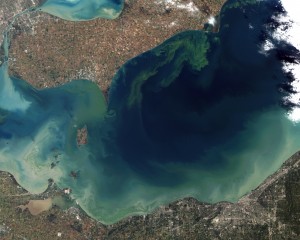It’s hard to get more fundamental than this. The water news this week focused on the toxic algal bloom in Lake Erie that poisoned Toledo, Ohio’s drinking water, and a federal study that discovered intersex fish throughout the Delaware, Susquehanna, and Ohio Rivers. But these stories really are just the tip of the iceberg: Many, many other locations throughout the country experience these problems as well and reveal that, despite past gains realized through the Clean Water Act, current protections aren’t getting the job done.

In Toledo, nutrient runoff – in particular, phosphorus from agricultural facilities – combined with summer sun and warm temperatures, has been feeding a huge algal bloom on the west end of Lake Erie for weeks. One of the species blooming on the lake was a type of bacteria called microcystis that releases a toxin harmful to the nervous system and liver, and can cause vomiting, cramps, and rashes. Last Saturday, when toxins finally exceeded safe levels, Toledo’s water officials told residents not to drink the water coming out of their taps. According to The Washington Post, Toledo’s water managers have worried about just this scenario for years as they watched algal blooms appear each summer in the lake.
Those of us in the Chesapeake Bay watershed are painfully aware of nutrient runoff causing algal blooms and associated dead zones in the Bay each summer. Typically, those dead zones are caused by dying algae consuming all the oxygen in the water, and get less attention than toxic blooms that spread harmful bacteria and can make us immediately sick. But that same toxic bacteria occurs in other water sources throughout the region. Tim Wheeler of The Baltimore Sun reports on at least three locations closed this summer due to microcystis, including a Girl Scout camp in Caroline County, Maryland. And although not every algal bloom in the region includes toxins, they all have a common source: excess nutrients from farms, lawns, and sewage systems.
The report on intersex fish is just the latest in a series of studies by the U.S. Geological Survey finding eggs in the testes of male smallmouth and largemouth bass, and elevated levels of a female protein in their blood. The first, back in 2003, found intersex bass in the Potomac River drainage, and later the Shenandoah and Monocacy Rivers. Another, in 2009 found the same problem in rivers throughout the West and Southeast, including in the Apalachicola, Colorado, Columbia, Mobile, Mississippi, Pee Dee, Rio Grande, Savannah River basins. In all cases, scientists believe chemicals that mimic female hormones, called endocrine disruptors, are probably to blame. These chemicals are found in many pesticides, human and livestock pharmaceuticals and waste, and other products. Some of the studies – including the most recent – found higher rates and severity of intersex characteristics in fish near agricultural areas and greater severity downstream of sewage treatment plants (which aren’t equipped to remove such chemicals from waste).
But scientists still aren’t totally sure what’s causing males to resemble females, in part because they don’t know exactly what chemicals farmers are using. Darryl Fears of The Washington Post reports that an effort to collect that information from farmers in Maryland was shot down last year because of concerns about the costs. Instead, Maryland passed a law setting up a fund to require mandatory pesticide reporting in the future to help answer remaining questions about intersex fish.
Regardless, it’s clear that current efforts to ensure drinkable, fishable, and swimmable waters aren’t enough. The city of Toledo lifted its water ban on Monday, and its summer crisis likely soon will be forgotten by most. But this is the second major American city this year to lose its drinking water because of contamination. In January, toxic chemicals from a storage tank contaminated drinking water in the city of Charleston, West Virginia, shutting down that city’s water supply for weeks. Months later, some residents were still afraid to drink the water.
Surely Americans thought they had left those days behind. Perhaps boy fishes turning into girls and pea green drinking water aren’t as colorful as flaming rivers – the impetus for passage of the Clean Water Act in 1972. But they sure come close.


Amy, good job! I linked this post to my post here.
http://www.gettingmoreontheground.com/2014/08/22/lake-erie-needs-a-pollution-diet/
bobby
Thanks Bobby! This is great to see as I return from vacation.